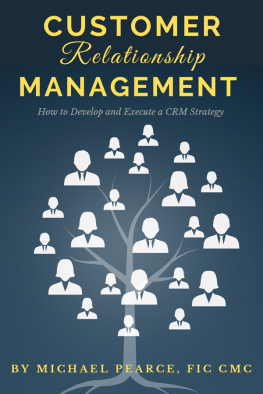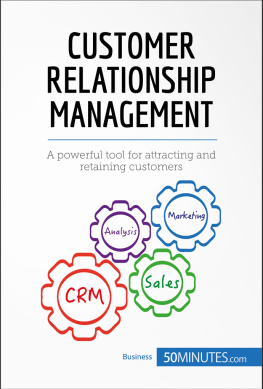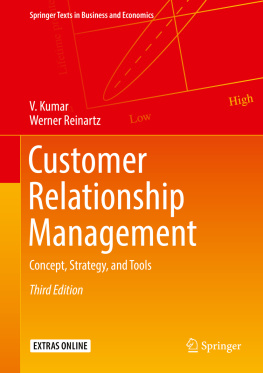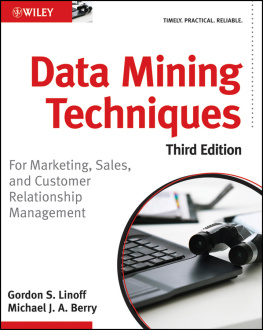Michael Pearce - Customer Relationship Management
Here you can read online Michael Pearce - Customer Relationship Management full text of the book (entire story) in english for free. Download pdf and epub, get meaning, cover and reviews about this ebook. year: 2021, publisher: Business Expert Press, genre: Business. Description of the work, (preface) as well as reviews are available. Best literature library LitArk.com created for fans of good reading and offers a wide selection of genres:
Romance novel
Science fiction
Adventure
Detective
Science
History
Home and family
Prose
Art
Politics
Computer
Non-fiction
Religion
Business
Children
Humor
Choose a favorite category and find really read worthwhile books. Enjoy immersion in the world of imagination, feel the emotions of the characters or learn something new for yourself, make an fascinating discovery.
- Book:Customer Relationship Management
- Author:
- Publisher:Business Expert Press
- Genre:
- Year:2021
- Rating:4 / 5
- Favourites:Add to favourites
- Your mark:
- 80
- 1
- 2
- 3
- 4
- 5
Customer Relationship Management: summary, description and annotation
We offer to read an annotation, description, summary or preface (depends on what the author of the book "Customer Relationship Management" wrote himself). If you haven't found the necessary information about the book — write in the comments, we will try to find it.
Customer Relationship Management — read online for free the complete book (whole text) full work
Below is the text of the book, divided by pages. System saving the place of the last page read, allows you to conveniently read the book "Customer Relationship Management" online for free, without having to search again every time where you left off. Put a bookmark, and you can go to the page where you finished reading at any time.
Font size:
Interval:
Bookmark:

Customer Relationship Management
Customer Relationship Management
How To Develop and Execute a CRM Strategy
Michael Pearce FIC CMC

Customer Relationship Management: How To Develop and Execute a CRM Strategy
Copyright Business Expert Press, LLC, 2021.
Cover design by Charlene Kronstedt
Interior design by Exeter Premedia Services Private Ltd., Chennai, India
All rights reserved. No part of this publication may be reproduced, stored in a retrieval system, or transmitted in any form or by any meanselectronic, mechanical, photocopy, recording, or any other except for brief quotations, not to exceed 400 words, without the prior permission of the publisher.
First published in 2021 by
Business Expert Press, LLC
222 East 46th Street, New York, NY 10017
www.businessexpertpress.com
ISBN-13: 978-1-95334-964-4 (paperback)
ISBN-13: 978-1-95334-965-1 (e-book)
Business Expert Press Marketing Collection
Collection ISSN: 2169-3978 (print)
Collection ISSN: 2169-3986 (electronic)
First edition: 2021
10 9 8 7 6 5 4 3 2 1
Description
CRM first entered the business vocabulary in the early 90s; initially as a systems driven technical solution. It has since escalated in importance as system providers increased their market penetration of the business market and, in parallel, CRMs strategic importance gained more traction as it was recognised that CRM was, at its heart, a business model in the pursuit of sustainable profit.
This was accentuated by the academic community stepping up their interest in the subject in the early 2000s. Today, it is a universal business topic which has been re-engineered by the online shopping revolution in which the customer is firmly placed at the centre of the business. The current reality, however, is that, for the vast majority of businesses, CRM has not been adopted as a business philosophy and practising business model. It has not been fully understood and therefore fully embraced and properly implemented.
The author addresses this head-on by stripping CRM down into its component parts by delving into and explaining the role and relevance of the C, R, and M in CRM. This is a practical guide but set within a strategic framework. The outage is clear actionable insights and how to convert them into delivery. It is written in an easily digestible, non-jargon style, with case studies to demonstrate how CRM works. This book can be immediately used as the primary practical reference to guide the development and implementation of a CRM strategy.
Keywords
relationship marketing; customer loyalty; targeted marketing; customer centric business model; database management; data mining; brand proposition; brand positioning; customer centric database; cloud based CRM systems; CRM; customer profitability; customer relationship management; customer segmentation; ROI; CRM strategy
Contents
To everyone I have met in my consultancy and business career who have helped shape my thinking on CRM as a business model fit for modern times, in which the customer should be at the center of all companies strategic planning. In particular, my thanks to friends and colleagues in Adactus who created the space and provided support to enable me to write this book.
Like many management innovations, a multitude of spins on the subject often rapidly emerge and can create distortions, myths, and misunderstanding of the true application and worth of the innovation.
CRM is no exception. Firstly, it is neither new nor an innovation. Any marketing orientated company can vouch for that where the customer has always been the center of their universe, and continuously seeking out and meeting customer needs (if not their wants) their mantra.
Secondly, the thrust of the drive to put CRM on the management agenda has largely been through software companies marketing proprietary CRM systems. Certainly these systems have made a real step change in data processing in capturing, storing, marshalling, analyzing, and applying data to enhance decision making. More importantly, they handle big data and supply it in a highly relevant way to all user groups who have customer touch points, to help enrich the customer experience. But, they are not CRM itself. They are one of the tools in the CRM toolbox. For sure they are a really important one and a key component of the CRM strategic operational framework, but CRM systems are processes. They are an integral part of the CRM strategy but not the strategy itself.
So, lets start by stripping down CRM to give an overview and identify and understand its role in a business.
Customer Relationship Management (CRM) relates to acquiring, developing, and retaining satisfied loyal customers. To achieve sustainable profitable growth, it is generally desirable for a company to increase the number of profitable customers, to increase the profit from existing customers, and to extend the duration of the customers relationship with the company (or brand).
In todays increasingly competitive business environment, a fundamental change has taken place. The emerging global and electronic economy has turned tradition on its head and, for consumer markets, placed the customer firmly in the driving seat: as a result of which, power has irreversibly shifted from the seller to the customer with customer choice (and competition) one Google search away. Customers are more demanding, more aware of their choices, and more in command than ever before. Add the fact that cost cutting alone will not generate long-term profit growth, it is clear that CRM is an enterprise wide imperative.
However, many companies are not ideally positioned to capitalize on the opportunity for customer-oriented growth. While some companies have made attempts to implement CRM solutions (frequently by installing CRM systems rather than adopting a top-down CRM strategy), they have often not transformed themselves into customer-driven enterprises. The actual results can be more a set of disconnected initiatives that fall short of creating real value.
A holistic approach is required for CRM to allow a company to orchestrate all the activities that bring it into contact with its customers to deliver a consistently differentiatedand personalizedcustomer experience regardless of the interactive channel chosen by the customer, embracing their experience with all touch points with the company. Such an approach can permit companies to knit together marketing, sales, and service functions that would have traditionally been pursued (are pursued) in separate ad hoc ways, and therefore, constitutes a more comprehensive, methodical approach to identifying, attracting, and retaining the most valuable customers.
CRM is therefore best described as a business philosophy; as a modern day approach to manage profitability by placing the customer at the center of the business. By definition, it is a corporate strategic approach and, as such, is driven by the Board of Directors with its impact company wide as to how it organizes itself to fully practice CRM.
About This Book
Welcome to the first edition of CRM: How to Develop and Execute a CRM Strategy. This book explains all the facets of CRM; its definition, its strategic role and application, and the approach to developing a successful CRM strategy through breaking it down into its constituent parts from both conceptual and practical perspectives.
Font size:
Interval:
Bookmark:
Similar books «Customer Relationship Management»
Look at similar books to Customer Relationship Management. We have selected literature similar in name and meaning in the hope of providing readers with more options to find new, interesting, not yet read works.
Discussion, reviews of the book Customer Relationship Management and just readers' own opinions. Leave your comments, write what you think about the work, its meaning or the main characters. Specify what exactly you liked and what you didn't like, and why you think so.






